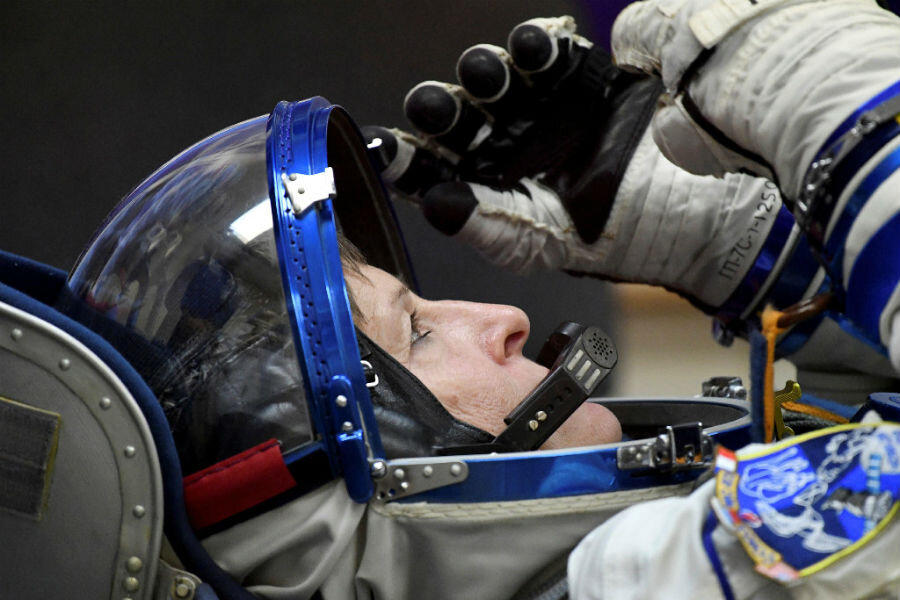Peggy Whitson logs more space hours than any other US astronaut: A history of women and NASA
Loading...
Early Monday morning, NASA astronaut Peggy Whitson set a new record for the longest time in space for any US astronaut, hitting a landmark 534 cumulative days in orbit. Fellow astronaut Jeff Williams set the previous record only last year.
Dr. Whitson will continue to extend the new record for the duration of her stay as current commander on the International Space Station, ultimately to more than 650 cumulative days, setting a high bar for those looking to break her record.
This is not the first time Whitson has made NASA history, however. The astronaut and biochemist also became the first woman commander of the ISS in 2007 and the first woman to command the station twice, earlier this year. She is also the oldest US woman to have completed a spacewalk, and has done more spacewalks than any other female NASA astronaut.
To many, Whitson's many accomplishments are striking examples of what women can accomplish in a space-related field. But her many firsts also stand as reminders of what still needs to be done to support women in STEM fields, allowing women to break new ground alongside men on the forefront of space technology and exploration.
Women have been a part of NASA history from the start. The early space program employed women in a number of on-the-ground capacities serving as administrative officials, medical personnel, mathematicians, and engineers.
But from the outset of the program, there was a clear preference to place men in top positions, with women often taking up lower-rung tasks despite equal or superior ability and educational background. The problem was particularly stark for potential astronauts; while a number female astronaut candidates tested well for potential space missions as far back as the Mercury program, it was decades before a woman was to actually be launched into space from US soil.
These potential astronauts faced many obstacles, including a 1958 policy that required all astronauts to be military test pilots, which effectively banned American women from going to space until the mid-1960s, since the military employed no female pilots at the time.
In the Soviet Union, Valentina Tereshkova became the first woman in space in 1963, but the superpower did not send another woman into orbit until 1982.
Even after the end NASA's military-pilots-only policy, a female American astronaut would not launch into space until 1983, when Sally Ride entered orbit on the space shuttle Challenger. Since then, women have become an increasingly visible part of NASA's space program, and have recently gained even greater recognition in popular culture, thanks to the award-winning film "Hidden Figures" about female African-American mathematicians at NASA in the late 1960s, and the recently approved "Women of NASA" Lego set.
"Women have played critical roles throughout the history of the U.S. space program, a.k.a. NASA or the National Aeronautics and Space Administration. Yet in many cases, their contributions are unknown or under-appreciated – especially as women have historically struggled to gain acceptance in the fields of science, technology, engineering, and mathematics (STEM)," wrote science writer Maia Weinstock in the Lego set proposal.
This kind of encouragement and positive representation is especially important for young girls, noted Whitman in a video conference between the White House and the ISS on Monday with President Trump, Ivanka Trump, and NASA astronaut Kate Rubins.
"I don't really think [being an astronaut] became a goal until I graduated from high school, when the first female astronauts were selected," Whitson said. She also said that traveling to Mars could be a real possibility in the coming decades and urged young students to focus on their studies in order to be a part of it.
"I want all the young people out there to recognize that the real steps [of traveling to Mars] are going to be taken in a few years. And so by studying math, science, engineering, any kind of technology, you're going to have a part in that. And that will be very exciting," Whitson added.
Examples of success can be an important part of encouraging girls to pursue projects and careers in more complex fields of study, especially in STEM fields, which are still largely dominated by men. As The Christian Science Monitor reported in October 2016:
Between 1901 and 2015, only 49 out of 870 Nobel prizes for individuals have been awarded to women. One explanation is that there are simply fewer women in science, technology, engineering, and mathematical (STEM) jobs, as the US Census Bureau data shows. But it leads to a question that many have been asking: Why aren't more women participating in STEM fields?
The answer, some experts say, may lie in working environment and gender biases that discourage women from progressing across scientific fields and sometimes entering it in the first place.
"What we're seeing is there is still very slow progress and a lot of attrition," Beth Mitchneck, professor of geography at the University of Arizona, tells The Christian Science Monitor in a phone interview. "Women leave the field to a higher degree than men – and academic or leadership positions, they're not getting [those]."
Of course, not everyone can be an astronaut. But astronauts have long held a special place in the heart of the American public, and their visibility often makes them role models for young people who are just beginning to consider the possibility of entering a STEM field. And breaking a record in space is a great way to encourage the next generation to work together to break even more records.
"It's actually a huge honor to break a record like this," Whitson said during the livestream. "It's an honor for me, basically to be representing all the folks at NASA who make space flight possible and who make me setting this record feasible."
Whitson is expected to return to Earth in September 2017.








